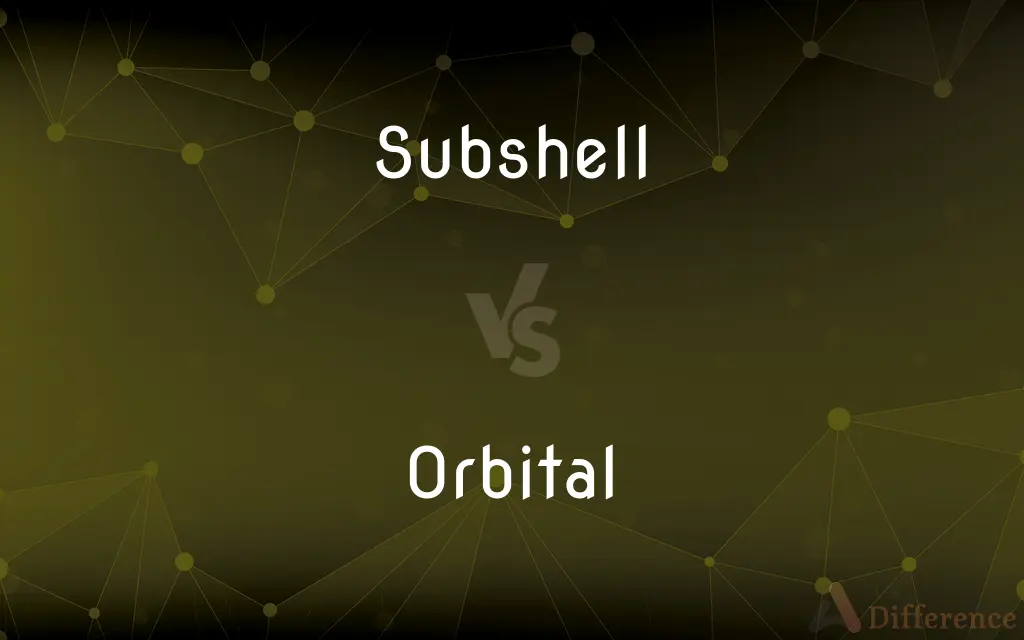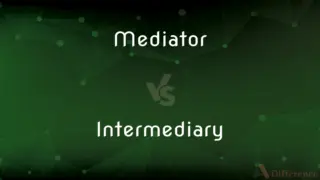Subshell vs. Orbital — What's the Difference?
Edited by Tayyaba Rehman — By Maham Liaqat — Updated on April 16, 2024
Subshells categorize electrons within an electron shell based on angular momentum; orbitals define specific regions where electrons are likely to be found.

Difference Between Subshell and Orbital
Table of Contents
ADVERTISEMENT
Key Differences
Subshells are divisions within electron shells, characterized by their angular momentum quantum number, while orbitals are more specific regions within subshells where electrons have a high probability of being located. Each subshell contains one or more orbitals.
Subshells are labeled as s, p, d, and f, indicating different shapes and capacities for electrons. Orbitals, on the other hand, describe the exact spatial distribution of electron density within these subshells. For instance, the p subshell includes three dumbbell-shaped orbitals.
Each type of subshell (s, p, d, f) supports a fixed number of orbitals: s has 1, p has 3, d has 5, and f has 7. This means orbitals can be more specifically targeted in quantum chemical calculations, whereas subshells give a broader overview of electron configuration.
Subshells help in predicting the chemical properties of elements by indicating the electron configuration in a simplified form, whereas the shape and orientation of orbitals are crucial for understanding molecular bonding and geometry.
Subshells contribute to the periodic table's structure by defining blocks (s-block, p-block, d-block, and f-block), while the arrangement and type of orbitals influence the chemical bonding and reactivity of an atom.
ADVERTISEMENT
Comparison Chart
Definition
Division of electron shells based on quantum numbers
Specific region in a subshell with high electron probability
Components
Multiple orbitals
Defined by wave functions
Types
S, p, d, f
S, p_x, p_y, p_z, d, and f orbitals, etc.
Role in Chemistry
Indicate general electron configuration and chemical properties
Essential for predicting molecular geometry and bonding interactions
Quantum Numbers
Includes principal (n) and azimuthal (l)
Includes magnetic (m_l) and spin (m_s)
Compare with Definitions
Subshell
A group of orbitals within an atom, defined by quantum numbers.
Electrons fill the 3d subshell after the 4s subshell in many transition metals.
Orbital
Influential in determining molecular geometry and chemical properties.
The shape of the d orbitals plays a crucial role in transition metal chemistry.
Subshell
A layer within an electron shell, classified by angular momentum.
The 2p subshell is higher in energy than the 2s subshell.
Orbital
The building block of molecular bonding theories.
Hybrid orbitals are formed from the mixing of standard atomic orbitals.
Subshell
A concept in quantum mechanics used to describe electron configurations.
The electron configuration of nitrogen ends in the 2p subshell.
Orbital
Defined mathematically by wave functions in quantum mechanics.
Each orbital is associated with a specific set of quantum numbers.
Subshell
A determinant in chemical bonding and reactivity.
Elements with electrons in the f subshell exhibit complex chemical behaviors.
Orbital
A key factor in the electron density distribution around an atom.
Electron density maps show how orbitals occupy space around a nucleus.
Subshell
A structural feature that affects an element’s position in the periodic table.
Transition metals are characterized by their partially filled d subshells.
Orbital
A region in an atom where there is a high probability of finding an electron.
The p orbital has a dumbbell-shaped probability distribution.
Subshell
One or more orbitals in the electron shell of an atom.
Orbital
Relating to an orbit or orbits.
Subshell
Atomic orbitals for which the values of the n and l quantum numbers are the same, such as the three 2p or five 3d atomic orbitals.
Orbital
An orbital road.
Subshell
(computing) A child process launched by a shell.
Orbital
Each of the actual or potential patterns of electron density which may be formed in an atom or molecule by one or more electrons, and can be represented as a wave function.
Orbital
Of or relating to an orbit.
Orbital
The wave function of an electron in an atom or molecule, indicating the electron's probable location.
Orbital
Of or relating to, or forming an orbit (such as the orbit of a moon, planet, or spacecraft).
Orbital
(anatomy) Of or relating to the eye socket eyehole.
Orbital
Passing around the outside of an urban area.
The M25 is an orbital motorway around London.
Orbital
Ellipsis of orbital motorway.
Orbital
(physics) A specification of the energy and probability density of one or more electrons at any point in an atom or molecule, and can be represented as a wave function.
Orbital
Of or pertaining to an orbit.
Orbital
Of or relating to an orbit;
Orbital revolution
Orbital velocity
Orbital
Of or relating to the eye socket;
Orbital scale
Orbital arch
Common Curiosities
What is a subshell in an atom?
A subshell is a division of electron shells in an atom based on the angular momentum quantum numbers, housing one or more orbitals.
How do orbitals differ from subshells?
Orbitals are specific regions within a subshell where electrons are most likely to be found, characterized by unique shapes and orientations.
How many types of orbitals are there in a p subshell?
There are three orbitals in a p subshell, typically designated as p_x, p_y, and p_z.
What is the difference between s and p orbitals in terms of shape?
S orbitals are spherical, whereas p orbitals are dumbbell-shaped.
Why are orbitals important in chemistry?
Orbitals are crucial for understanding electron distribution and chemical bonding patterns in molecules.
How do electrons fill subshells and orbitals?
Electrons fill subshells and orbitals according to the Aufbau principle, Hund’s rule, and the Pauli exclusion principle.
How are orbitals visualized in chemical studies?
Orbitals are often visualized using electron density plots or computational models in molecular chemistry.
Can a subshell exist without orbitals?
No, subshells are composed of orbitals; they cannot exist without them.
What role does the subshell play in the periodic table?
Subshells help define the blocks of the periodic table (s-block, p-block, etc.) and influence the chemical properties of elements.
How does the electron configuration indicate subshell filling?
Electron configuration outlines the order in which subshells and orbitals are filled with electrons, based on energy levels.
What impact does orbital theory have on modern chemistry?
Orbital theory provides a fundamental basis for understanding and predicting molecular structures, reactivities, and properties.
What determines the shape of an orbital?
The shape of an orbital is determined by its quantum numbers and the mathematical solutions to the Schrödinger equation.
Why are d and f orbitals crucial in transition metals and lanthanides?
The d and f orbitals allow these elements to exhibit a wide range of oxidation states and complex chemistry.
What is the significance of orbital hybridization?
Orbital hybridization is significant for explaining molecular shapes and bonding properties beyond simple orbital overlap.
Can the number of orbitals in a subshell vary?
No, the number of orbitals in a specific type of subshell (s, p, d, f) is fixed.
Share Your Discovery

Previous Comparison
Rescue vs. Recovery
Next Comparison
Mediator vs. IntermediaryAuthor Spotlight
Written by
Maham LiaqatEdited by
Tayyaba RehmanTayyaba Rehman is a distinguished writer, currently serving as a primary contributor to askdifference.com. As a researcher in semantics and etymology, Tayyaba's passion for the complexity of languages and their distinctions has found a perfect home on the platform. Tayyaba delves into the intricacies of language, distinguishing between commonly confused words and phrases, thereby providing clarity for readers worldwide.
















































